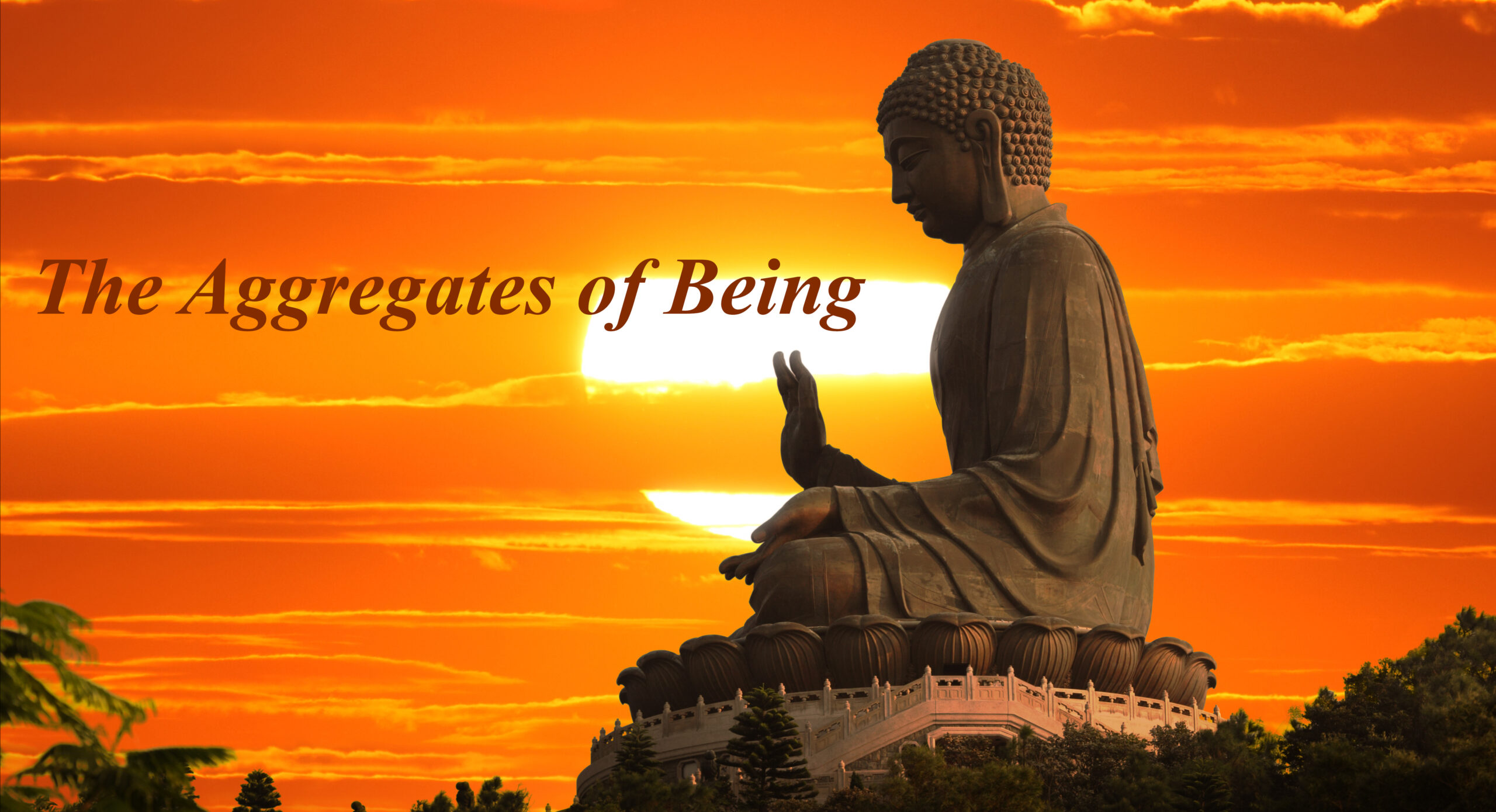In this post, we discuss the Five Aggregates. Aggregate is known in Sanskrit as skandha.
Skandha (Chinese=蘊), according to The Princeton Dictionary of Buddhism, is “in Sanskrit, lit. “heap,” viz. “aggregates,” or “aggregates of being.”
Buddha enumerates the following Five Aggregates of Being.
- Rupaskandha (Chinese=色蘊), the Aggregage of Rupa;
- Vedanaskandha (Chinese=受蘊), the Aggregate of Sensing or Receiving;
- Samjnaskandha. (Chinese=想蘊), the Aggregate of Active Mentality;
- Samskaraskandha (Chinese=行蘊), the Aggregate of Action; and
- Vijnanaskandha Chinese=識蘊), or the Aggregate of Consciousness
When discussing inferentially connected words in a previous post, human epistemology, Dr. Fisch enumerates the following five steps he calls “sensing.”
- “the world impacts on us in a causal manner through all our sensors,”
- “the content imparted on those stimuli is the reading-in of the mind,”
- “the content gets fashioned and conceptualized by our minds in ways that we do not govern,”
- “Sitting in the command room of our minds with the inner-eyes and looking out,”
- “seeing on the screen the world that we experience.”
In the following discussion, we use Dr. Fisch’s five steps to help explain each of the five aggregates.
1) Rupaskandha (Chinese=色蘊), or the Aggregate of Rupa.
Rupa, as defined in an earlier post, is “body,” “form,” or “materiality.” Furthermore, according to The Princeton Dictionary of Buddhism, “more generally, repa refers to the materiality, which serves as the object of the five sensory consciousness (vijnana); visual, auditory, olfactory, gustatory, and tactile.” In other words, rupa represents what we see, hear, smell, taste, and touch, i.e., everything in the phenomenal world.
So, the Aggregate of Rupa corresponds to what Dr. Fisch describes as “the world that we experience.”
2) Vedanaskandha (Chinese=受蘊), or the Aggregate of Sensing or Receiving.
Vedana (Chinese=受), according to the Princeton Dictionary of Buddhism, is “in Sanskrit and Pali, “sensation,” or “sensory feeling.” The Chinese translation of Vedana is “to receive or accept.”
Therefore, the Aggregate of Sensing or Receiving corresponds to what Dr. Frisch describes as “the world impacts on us in a causal manner through all our senses.” The senses, of course, are the visual, auditory, olfactory, gustatory, and tactile senses mentioned earlier in step one.
However, while Dr. Fisch suggests that “the world impacts on us in a causal manner through all our senses,” he makes no mention of in what manner the world impacts on the senses. Specifically, what is the “content” of the impact that gets conceptualized in the next step? Without any content, there is nothing to conceptualize and, therefore, no impact.
Dr. Fisch can be excused for not knowing. With only inferentially connected words to understand the world, no unenlightened person can be expected to know because the “content” the sensors receive is the “experiential content” of mentality, first discussed when discussing Citta and Enlightenment.
“Experiential content” has two important meanings.
- “Experiential” means that the content can be directly perceived. Directly perceiving is what eyes, ears, noses, tongues, and bodily senses do.
- “Content” refers to the information inherent in the mental construct of everything in the world. The contents that “the world impacts on us in a causal manner through all our sensors” are what Dr. Fisch calls empirical facts. To Buddha, they are “all objects of knowledge.”

Dr. Tong’s image was used in our discussion on the Four Realms of Reality. Our current discussion focuses mainly on the third Dharmadhatu, “The Dharmadhatu of Unobstructed Interpenetration between Principle and Phenomena.”
As it was written then about this Dharmadhatu, “in science, the “dharmadhatu of the unobstructed interpenetration between principle and phenomena” is called wave-particle duality, also known as the central mystery of quantum mechanics, which says that “everything in the universe, from light to electrons to atoms, behaves like both a particle and wave at the same time. Wave-particle duality is not only true with the ripples in the quantum realm, but it also applies to galaxies in the sky, as the image from Dr. Tony Tyson shows.”

As Dr. Tyson’s images also show, even massive galaxies are ripples that connect with other phenomena in the sky. Indeed, all phenomena that look solid are not solid. In their essence, all phenomena are just fluctuations. or are deemed physical or material are just fluctuations.
Therefore, when senses sense, there is no “physical” world crashing on them to give them information. Instead, what impacts our senses are the waves of fluctuating mentality carrying the “experiential content” embedded in it.
3) Samjnaskandha. (Chinese=想蘊), the Aggregate of Active Mentality.
Samjna, according to The Princeton Dictionary of Buddhism, is “in Sanskrit, “perception,” “discrimination,” or “(conceptual) identification.” The Chinese translation of Samjna is “to think.” Either way, all these varied descriptions signify an active mentality.
An active mentality is important because it allows the “reading-in” of the mind. When the mind is quiescent, there can be no “reading-in” of the mindand, therefore, no universe, as Adyashanti and others affirmed.
4) Samskaraskandha (Chinese=行蘊), the Aggregate of action.
Samskara, according to the Princeton Dictionary of Buddhism, is” in Sanskrit, a polysemous term that is variously translated as “formation,” “volition,” “volitional action,” “conditioned,” “conditioning factors.” The Chinese translation of samskaraskandha is “action.”
After the “reading-in” of the mind, the “action” in the mind, as Dr. Fisch describes, is the fashing and conceptualization of what the senses sense “in ways that we do not govern.”
5) Vijnanaskandha Chinese=識蘊), or the Aggregate of Consciousness
Vijna, according to the Princeton Dictionary of Buddhism, is “consciousness.”
To discuss the meaning of this Aggregate, we start with the Consciousness-Only School of Buddhism.
Consciousness-Only School of Buddhism (Romanized Sanskrit=vijñanavada; Chinese=唯識宗), “also known as the Yogachara school, is one of the two major Mahayana schools in India. Maitreya, who is thought to have lived around 270-350 (350-430 according to another account), is often regarded as the founder of the Consciousness-Only school. This school upholds the concept that all phenomena arise from the vijnana or consciousness and that the basis of all functions of consciousness is the Alaya-consciousness.”
According to The Princeton Dictionary of Buddhism, “the cardinal doctrine of the Consciousness-Only School is that “the objects of experience are mere projections of consciousness. Thus, all objects are mere representations, and all categories are mere designations. No object is the natural basis of its name; rather, the mind itself instead designates the object.”
In other words, the function of the Aggregate of Consciousness is to project the results of the conceptualizations as “objects of experience.” In Dr. Fisch’s words, projecting the “object of experience” is like “Sitting in the command room of our minds with the inner eyes and looking out.”
With “objects of experience” projected, one can “see on the screen the world that we experience,” which is back to step one.
In summary, the Five Aggregates tell us that rupa, the “body, form, and materiality” of the phenomenal world, are projections of consciousness of the conceptualized “experiential content,” which the “world impacts on our senses.” These conceptualized images are then seen “on the screen the world that we experience.”
In other words,
- The world we experience has nothing to do with the contents the senses sense from the outside world.
- Instead, by the time humans experience the world, the contents our senses sense has already been conceptualized, distorted beyond recognition from the original content.
- Without projection from consciousness, the world does not exist. Therefore, Buddha deems the self-nature of the phenomenal world imputed, imaginary, or artificial.
The significance of the Five Aggregates doctrine is that it leads to an understanding that the world we experience is not what it seems. To use Newton’s words, while the world appears to have been built from “solid, massy, hard, impenetrable, movable particles,” it is not.
Quite to the contrary, the world humans experience is created in our minds and projected out “to be seen on the screen” as the world we experience. When our minds are not active, the world we experience vanishes. As discussed previously, Adyashanti and others have verified this imaginary nature of the phenomenal world.
In the next post, we will discuss the one word Buddha uses to indicate the mental nature of the phenomenal world and why considering the phenomenal world as real is delusional.


